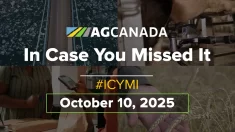Carney government drops first federal budget
The 2025 federal budget put a hefty focus on trade – particularly diversifying away from the United States.
It boasted about 1 trillion dollars in investments and a 78.3 billion dollar deficit.
Read Also

Crop Life hopeful Pest Management Regulatory Agency will cut red tape
The federal budget includes a line about removing cyclical reviews of pesticides on the market. That could free up the Pest Management Regulatory Agency to focus on other tasks
The budget, if passed, would set a goal to double non-U.S. exports over 10 years – a move it said will generate 300 billion dollars worth of new trade. This included a new strategic exports office at Global Affairs Canada.
It also identified the Asia-Pacific region as a critical market for Canadian agriculture and pledged 8 million dollars to deepen trade relationships in the European market.
On the domestic front, the government pledged 5 billion dollars over seven years for a trade diversification corridors fund.
Agriculture, trade groups react to federal budget
The 2025 budget took a step forward in recognizing the importance of the agriculture sector, according to the Canadian Federation of Agriculture.
CFA president Keith Currie pointed to investments in infrastructure and the organization praised measures to help the Canadian Food Inspection Agency expand market access. Grain Growers of Canada also praised attention to trade diversification, calling new investments in digital export tools a positive step.
A permanent reversal of controversial capital gains changes also received commendation.
However, organizations flagged plans to cut Agriculture Agri-Food Canada’s budget by 15 per cent. The Fruit and Vegetable Growers of Canada said this could hamstring efforts to modernize agriculture safety nets.
The Canadian Federation of Agriculture also lamented a lack of measures to address labour disruptions and farmland protection.
Government support for Canadian farmers has plummeted
The share of Canadian farmers’ gross revenue from government supports has dropped significantly in the last 40 years.
Total support for the sector is about 8.2 per cent of gross farm receipts according to OECD statistics.
For comparison, American farmers see about 7 per cent of gross receipts from government programming.
European farms see 16.4 per cent.
This is down from 30 to 35 per cent of farmers’ revenue in the 1980s. In the 2000s, the share was about 18 per cent. And recent years, that figure has sat around 7.9 to 9.1 per cent.
The farmer has to lose money before they get payments from government risk management programs, said economist Al Mussell. “The fewer the losses, the less the payments.”
















